원문 위치
http://www.agnisoft.com/white_papers/active_directory.asp
Active Directory Service Interfaces
Author: Deepak Shenoy
![]() Introduction
Introduction
![]() ADSI Architecture
ADSI Architecture
![]() Using ADSI in Delphi
Using ADSI in Delphi
![]() ADSI Schema
ADSI Schema![]() Providers
Providers ![]() Conclusion
Conclusion
References
(Download the code for this article at http://www.agnisoft.com/downloads (adsicode.zip)
![]() Introduction
Introduction
Microsoft has released Active Directory Service Interfaces (ADSI) for Windows 9x, NT and Windows 2000, and now it's inbuilt in Windows 2000. The Windows 2000 application specification states that you must use Active Directory when you can, so now you're thinking: How are YOUR applications going to adapt? What changes do you need to make? How are you going to use Delphi effectively to make these changes? This is what I intend to address in this presentation.
Let me first introduce a “directory service”. A directory service is like a telephone directory: if you have a person’s name, you can find his/her phone number. A directory service keeps track of “resources”, which could be anything – a file system is a directory that keeps track of files and folders, an email server is a directory service that indexes users, user groups etc. There are many directory services already in place: we already have file systems and email servers. What’s so different? Traditionally, you’d have to use different API’s (Application Programming Interfaces) to access different directory services – which :
- Limit you to the vendor’s directory service. For example, if you wrote an application that extracted email information from Microsoft Mail and used the Mail Application Programmers Interface (MAPI), you would find it difficult to move to a different vendor.
- Increase development time for your applications because you need to learn more API’s to get your application working.
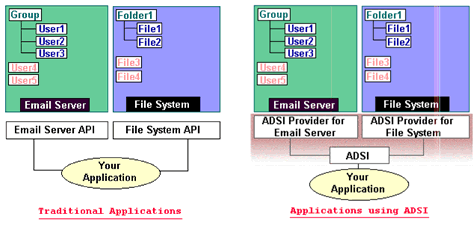
There is a need to have a common model that every directory service would support – similar to the ODBC programming model that all (or most) database vendors now support. A model that will support a hierarchy of resources, like folders and files, and be simple to use. Active Directory provides this model. To access an Active Directory, you will use Active Directory Service Interfaces(ADSI).
Where is Active Directory used?
"Active Directory" encapsulates all directory services - a list of printers on a network, a set of services on an NT server etc. Directory services are very useful in an enterprise where one might know what he wants, may not know what that resource is named. (like, "give me a list of printers in the 2nd floor").
Any directory service can choose to publish itself as an Active Directory, so that a common querying mechanism can be used. At this point the following products support Active Directory:
- Microsoft Exchange Server: Allows queries for email ids, names and a number of other attributes of people or groups across an enterprise.
- Microsoft Site Server: Stores the list of users as an Active Directory.
- Microsoft Windows NT: This gives you uniform access to users (earlier through User Manager for Domains), services (earlier through service manager) and network resources (computers, printers etc.)
Active Directory also provides bridges to access other similar directory services, like LDAP, NDS (Novell Directory Services) etc.
Active Directory is also an integral part of Windows 2000. In a large organization, Windows NT server has been used as a Primary or Backup Domain Controller, but it was difficult to integrate many such controllers to be able to provide security and privileges across the organization. Active Directory makes it simpler by allowing you to structure your organization into units which seamlessly (or so they say) integrate with each other. Which also means lesser problems when you expand, add more servers, more users etc.
To know more about how you can use Active Directory effectively in your organization, please visit: http://www.microsoft.com/windows2000/library/technologies/activedirectory/default.asp
Here's a list of places ADSI would be best used in:
- User/Groups:Adding/Deleting users , Finding out if a user is a member of a group.
- Changing a user's password
- Starting and stopping services.
- Getting printer information (jobs in print queue etc.)
- Adding/Deleting web or FTP sites from Microsoft Internet Information server.
- Getting user attributes from Microsoft Exchange Server, like email ids, Addresses, web directories etc.
These are just a few applications, and I'm sure there will be more as time goes on.
Prerequisites – What do you need to know?
This presentation assumes readers know COM (Component Object Model) and a working knowledge of using COM in Delphi.
What is ADSI?
Directory Services and Namespaces
There could be many objects within a namespace (users in an email server, files in a file system) which need to be uniquely identifiable by name. But you might have a user in the email server with the same name as a file in the file system:and they have no idea about each others existance. To maintain uniqueness, object names are prefixed with the name of the Directory Service they belong to. This name identifies a "namespace", with a namespace identifier like "WinNT:", "LDAP:" etc. (The ":" means that it's a namespace, and therefore, a directory service)
Object names are prefixed by the namespace identifier, and "//".
Note:This has analogies in the Internet, where you'd have Web pages identified by "http://..." and files on FTP servers by "ftp://..." etc.
ADSI in a nutshell
As Microsoft puts it, “ADSI is a set of COM programming interfaces that will make it easy for customers and Independent Software Vendors (ISVs) to build applications that register with, access, and manage multiple directory services with a single set of well-defined interfaces” (Ref.1) Active Directory Service Interfaces abstract the capabilities of individual directory services: which means you, as a developer, could access a file system the same way you access an email server or any other service that supports ADSI.
ADSI objects are Component Object Model (COM) Objects. You needn’t learn a new API for ADSI programming. You can develop for ADSI using simple Automation concepts. All ADSI objects support (and must support) IDispatch, so you can choose to use Late Binding or Early Binding. (Delphi supports both, quite magnificently) Here’s a small example of how to create a user on Windows NT 4.0 using Early Binding.
|
var |
Note: The ADsGetObject function is declared in AdsHlp.pas that is included with this article. The interface definitions are imported from ActiveDS.tlb in the WinNT/System32 folder. You will need to install ADSI 2.5 from http://www.microsoft.com/ntserver/nts/downloads/other/ADSI25/default.asp.
I will explain the architecture in more detail in the Architecture section. Active Directory Service Interfaces can be used easily in Delphi, though all the examples and support in the http://www.microsoft.com/adsi are in Visual Basic or C++ code. With this paper, you will find all the translations of the header files, some samples and some new Delphi translations.
A Directory Service Provider is a module that gives a user access to a certain directory service. For instance, we were able to add a user to the Windows NT user manager because Microsoft has written an ADSI provider for the user manager.
This doesn't sound very great, you might say. What's the difference between doing this and using native Windows NT calls to add users? First, this is COM based so if Microsoft decides to change the entire implementation of the user architecture, your applications are safe, because there will still be an ADSI provider supporting the same interfaces. (Note: this kind of thing might not be about to happen.)
Second, consider your gains in extensibility. You can now add a user on a Netware Server using very similar code, except you'd have to use the ADSI provider for Netware. As we will see later, the code will follow a similar pattern for doing different activities: creating a web site, adding an email user etc.
Take a look at the next section for more benefits.
Why should you use ADSI?
|
Feature |
Benefit |
| Open | Any directory provider can implement an Active Directory Service Interfaces provider; users can easily move to a different provider of the same service with a minimum rewrite. |
| Security | ADSI supports both Authentication and Authorization programming model - You can give even role based security for your applications. |
| Simple Programming Model | As you will see, the COM model is very easy to understand. The model remains standard for all providers: there's no need to understand vendor specific APIs. |
| Automation Server | Any Automation Controller (for example, Delphi, Visual Basic, C/C++ and others) can be used to develop directory service applications. Administrators and developers can use the tools they already know. |
| Functionally Rich | ISVs and sophisticated end users can develop serious applications using the same Active Directory Service Interfaces models that are used for simple scripted administrative applications. |
| Extensible | Directory providers, ISVs, and end users can extend Active Directory Service Interfaces with new objects and functions to add value or meet unique needs. |
The Architecture of ADSI
This section deals with the core concepts of ADSI. There will be
- a description of the COM object model and
- an introduction to the various interfaces
Overview
Most directory services are hierarchical in nature and thus lend themselves to a hierarchical object model. ADSI abstracts this concept by defining Container Interfaces and leaf interfaces. A container object (that implements a Container Interface) will contain zero or more ADSI objects - which could be other containers or leaf objects. As I've said before, access to directory services is through ADSI providers - so each provider is identified by a unique namespace identifier. A provider implements a Namespace object which is a COM Object that is a one-stop-shop: you can access any object in the namespace through this object.
These namespace objects are stored in an Active Directory Namespace Container object which is identified by the name "ADS:". (See Figure).
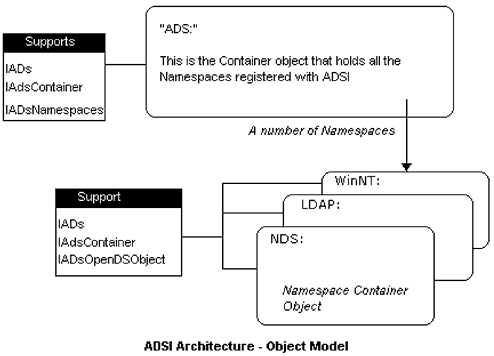
Each Namespace object is itself a container - it contains the root nodes of the directory service objects. Every container object and leaf object support a common set of methods - so that users can interact with it uniformly. These common methods are part of the IADs interface for all nodes, and IADsContainer interface for container nodes.
These common methods do not expose all the functionalities of a provider - simply because the domain of a "directory service provider" is too large to be able to abstract everything. To allow providers to extend functionality, ADSI supplies a schema model that I will describe later.
COM Object Model
There are many ADSI Interfaces that have been defined for specific purposes. Here is a list:
| IADs | Object Identification Fundamental interface required on all ADSI objects. You use this interface to get and set properties. |
| IADsContainer | Object Lifetime Management and Detection Fundamental interface to be supported on all ADSI container objects. Manages object creation, deletion, copying and moving, binding, and |
| IADsPropertyList | Object Property Management Manages an objects properties in the property cache. You can use this to get and set properties. (Alternatively from IADs) |
| IDirectoryObject | Direct Object Access Low-level object access for clients that do not want to use Automation (Early binding) . Really useful when you want to get/set many properties in one call, instead of using multiple IADs.Get or IADs.Set calls.. |
| IUnknown | COM Object Management Required on all COM objects. |
| IDispatch | Type Library Information and Method Invocation Required on all Automation objects. ADSI Objects must support this interface. |
As an analogy, consider any Delphi application. There's a global object called Screen that contains information about all the forms created(Screen.Forms). Each form has a set of standard properties (Name, Tag for example).
Each form could contain many components in it, each of which has the standard properties (Name, Tag) at least. So a Form is analogous to a "container" in ADSI. In congruence, Screen is also a container.
Taking this further, a "Form" is a namespace - Any object in this namespace is derived from TForm and thus supports everything that TForm does. One more thing: ADSI requires that any object has a unique name: if we assume that all forms had unique names (which they usually will), then I could identify any object (Form ) by using its name. If I had to register this globally - I would prefix the name with "Form:". (Form:MainForm for instance). So "Form:" is handled by the Screen object which figures out where "Mainform" is. (You could have other namespaces handled by other containers)
To translate this to ADSI, we would have to have TForm support :
- IADs (All ADSI objects)
- IADsContainer (All ADSI Container objects)
All components (hosted on TForms) should support
- IADs ((All ADSI objects)
TScreen should support
- IADs (All ADSI objects)
- IADsContainer (All ADSI Container objects)
- IADsOpenDSObject (All ADSI Namespace container objects)
(This is only an example to demonstrate the ADSI object model. It might not be the best way to have your application support ADSI.)
If this was implemented, you can create any form by calling Screen.OpenDSObject('Form:MainForm');. With ADSI, there are libraries present so that you can open an object directly, given its path. You don't need to create the namespace container in order to create an object. A few functions here are:
- ADsGetObject(Path, Interfacename, Object) - returns an instance of the object who's name is Path. To avoid round trips with QueryInterface, (See Effective COM by Don Box et. al) the second parameter is an Interface ID that determines which interface will be returned.
- ADsOpenObject - Similar to ADsGetObject, except you can log on using a different identity to get the parameters. The security model in ADSI works with NT User security, so you can have role based security work for you.
- ADsBuildEnumerator, ADsEnumerateNext, ADsFreeEnumerator - Helper functions for the IEnumVARIANT interface, which allows Visual Basic developers to use the for each syntax.
Using ADSI in Delphi
In this section I will talk about how you can use ADSI in Delphi. I've used a number of samples from the Windows Platform SDK as a reference. If you take a look at this, most examples you will find will use late binding : Visual Basic code or VBScript/ASP code. I'll use a combination of Late and Early Binding - Delphi can use both - to demonstrate various features.
Binding to an ADSI object and enumeration
Binding string
A directory may contain a large number of items. Each item must be uniquely identifiable. ADsPath is a property available on any ADSI object which uniquely identifies it, both on a particular provider and across providers. Each provider corresponds to a namespace: Consider a few ADSI providers that ship with ADSI.
- WinNT: - The Windows NT provider for Windows NT 4.0 (and Windows 2000) domain controllers.
- LDAP: - For communication with LDAP servers like Exchange Server 5.5.
- NDS: - Provider for Netware Directory Services
(The initial elements of the ADsPath string are the namespace identifier (progID) of the ADSI provider, followed by "//", followed by whatever syntax is dictated by the provider namespace)
With this information at hand, lets consider a few ADsPaths that could identify objects.
- WinNT://MyDomain/Adminstrator - identifies the Administrator user on MyDomain, a Windows NT domain.
- LDAP://EXCHSVR/CN=info,DC=AGNISOFT,DC=COM - the info@agnisoft.com account on EXCHSVR
To find all the providers installed on your machine, you can enumerate the namespaces in "ADs:". Here is some Visual Basic code that does it:
|
Set x = GetObject("ADs:") |
Since we do not have the "For Each" syntax in Delphi, I will use the helper functions provided by ADSI to enumerate containers.
|
var x : IADsContainer; |
The binding code is in ADsGetObject( 'ADs:', IID_IADsContainer, x);
This code is a bit complex and troublesome to do everytime. I've added a funtion that allows easy enumeration.
|
procedure ADsEnumerateObjects(Container : IADsContainer; |
You can use this in a Delphi form like so:
|
procedure TForm1.Button2Click(Sender: TObject); |
You may also use ADsOpenObject for binding, the only difference being that you can choose to bind as a different user instead.
|
hr := ADsOpenObject('IIS://localhost', 'Admin','Admin', |
Connection Caching
ADSI caches connections to servers - on all objects not yet destroyed. So, if you will bind to many objects, you can create a dummy object that binds to some object on the server, perform your set of operations using a different set of objects and finally, released the dummy object.
Accessing properties.
Once Binding is established, you will want to get or set properties of the object. The steps involved are:
a) Bind to the object
b) Set properties
c) Call SetInfo
d) Release the object
(b) and (c) are required because ADSI caches the properties on the client side and updates the server only when you call SetInfo. (Saves a lot of network traffic this way).
Here's an example.
|
// Late Binding |
Note: In 'WinNT://AGNISOFT/Deepak', AGNISOFT is the Active Directory Domain and Deepak is the user name. FullName is a property of every user.(earlier accessible using User Manager for Domains)
Properties could also have multiple values, like additional phone numbers. You would use the PutEx and GetEx functions to set or access these properties.
|
var obj : IAds; |
Searching Active Directory
1. Using ADO
Active Data Objects is Microsoft's latest Database Access solution. It works with OLE DB providers, and ADSI comes with a provider named "ADsDSOObject". In Delphi, all you need to do is to drop a TADOConnection and set its provider to "ADsDSOObject". Then, drop a TADOQuery, connect it to the TADOConnection and query ADSI - this is a method for simple searching.
Here's how I've got all the users, their user names and their last names from my machine's Active Directory.
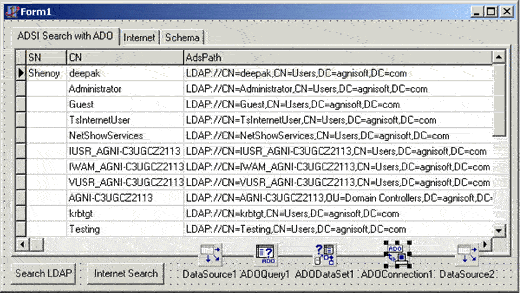
The SQL syntax is :
SELECT [ALL] select-list FROM 'ADsPath' [WHERE search-condition] [ORDER BY sort-list]
The Query I have used in the form is
|
SELECT AdsPath, CN, SN FROM 'LDAP://DC=AGNISOFT,DC=COM' WHERE objectClass='user' ORDER BY sn |
The ADSI provider is read-only at this time. Microsoft plans to ship a read-write provider in future. To modify data, you can:
1. Get the ADsPath from the Query
2. Use ADsGetObject to bind to the ADsPath
3. Get/Set properties
At this point, only the LDAP and the NDS providers support searching using ADO. You cannot use ADO to search for user in a Windows NT (Or 2000) domain.
2. Using COM Interfaces - IDirectorySearch
If you don't want to use ADO, you can use the IDirectorySearch Interface. The steps involved are:
1. Bind to the object
2. Call QueryInterface on the object for IDirectorySearch
3. Call IDirectorySearch.ExecuteSearch, passing the search query and get a search handle
4. Call IDirectorySearch.GetNextRow and for each row, call IDirectorySearch.GetColumn(columnName) to get the columns.
|
// bind to the object |
Security
ADSI supports Authentication using a login name and a password. If you use ADsGetObject then the user currently logged on is used to authenticate the login. You can specify a user name by using ADsOpenObject.
Example:
hr := ADsOpenObject('IIS://localhost', 'testuser','pwd',
ADS_SECURE_AUTHENTICATION , IADs, obj );
ADS_SECURE_AUTHENTICATION specifies that Kerberos or NTLM is used to authenticate the password. You can even specify password encryption (if your server supports it).
Role based security to properties - You might need to secure ADSI itself - control who can read/write certain properties etc. The properties of ADSI are controlled by Access Control Entries (ACEs) in Windows 2000. You can create an ACE and add it to the Discretionary Access Control List (DACL) of the SecurityDescriptor of an object. ( Use obj.Get('ntSecurityDescriptor') to get the security descriptor) The ACE can allow or deny access to one or all properties of an object. The security is inherited - so if you change the access control list of a container, all its descendants will inherit it.
Supporting ADSI
In the Windows 2000 application specification, it is recommended that you use ADSI in your applications in specific instances.
1. If your application will use a known directory service, you must use ADSI to get or set properties in the Active Directory service. For instance, if you need to add or modify a user, you must use ADSI to do so.
2. In a client-server or multi-tier application, you are suggested to publish server attributes in the Active Directory. Which means that the client applications should be able to use ADSI to get all the information about the server application.
To do this, you need to be able to extend ADSI. I'll talk about two ways you could extend ADSI. But first, lets see how the ADSI Schema works.
ADSI Schema
The predefined ADSI objects have very few properties: these may not be enough for a particular provider. So, ADSI allows your provider to extend the basic interface by adding properties to objects within your namespace. The schema objects are special ADSI objects : They allow you to :
- Browse the definition of objects
- Extend the definition of objects
The schema object contains definitions of :
- What kind of objects will be present (eg. in WinNT:, you have Users, Groups, Services etc),
- What properties these objects will have (For Users in WinNT:, FullName, Description etc. are properties) and which properties are mandatory and which are optional.
- The syntax of these properties (FullName is a String, UserFlags is an integer etc.)
(1) above is represented by a Class Object.
(2) by a Property Object
(3) by a Syntax object
These three are placed in the Active Directory as follows:
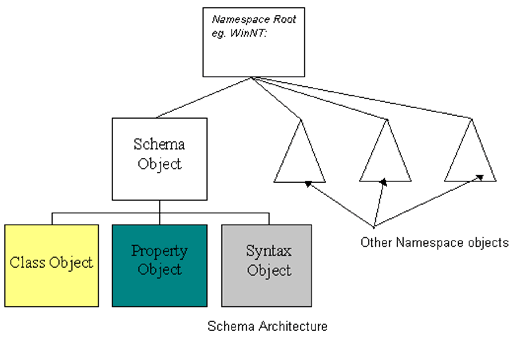
To browse the schema of an object, you must:
1. Get the ADsPath of the schema - The IADs.Get_Schema call does the job
2. create the schema object and browse it.
Here's an example that gets the list of Mandatory and optional properties of all Users in the LDAP namespace.
|
var obj : IAds; |
Here's a small application screenshot that does this:
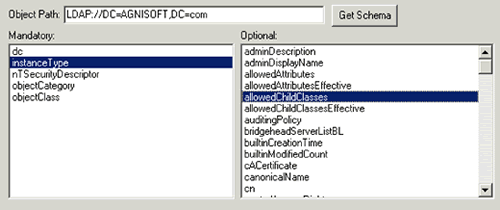
ADSI Extensions
ISVs or corporate developers can extend the object semantics by adding interfaces to the existing ADSI interfaces. ADSI combines the COM Aggregation model and directory technology to bring a powerful extension model. You can thus support more functions than provided by any of the standard ADSI interfaces.
Anyone that needs to extend ADSI can do so by writing an extension - which is nothing but a COM object. A backup vendor, for instance, could write an extension that supports "Backup" and "Restore" functions that extend the IADsComputer interface - This would be useful for administrator to write scripts for automatically backing up computers to a tape drive.
Writing Providers
To provide access to a totally new namespace, you must implement an ADSI provider. An ADSI provider could just be a single COM DLL containing many COM classes that you implement. Any provider needs to support:
1. A top level namespace object that supports IADsOpenDSObject and IParseDisplayName. (And of course, IADs) YOu will need to parse any AdsPath given and detect syntax errors, if any. 2. A few other interfaces-IADsPropertyList, IADsPropertyEntry, IADsPropertyValue, IDirectoryObject. (I won't go into detail on these interfaces)
3. IDispatch - this is very important because you must support late binding.
4. IADsContainer on all object containers.
5. IEnumVariant on all enumeratable objects (containers, collections).- You need to support those Visual Basic and VBScript users using for each.
6. A schema class container object with appropriate class, syntax and property objects for your namespace.
This seems like quite a big task, and though there is a sample in the Windows 2000 platform SDK, it isn't quite easy. I have written a sample in order to make it easier for you to begin - it's available along with this article.
Conclusion.
Windows 2000 supports Active Directory natively-there are four providers (WinNT:, LDAP:, IIS:, NDS:) already present in the Windows 2000 server install. At the time of writing this paper, the other applications supporting ADSI are Microsoft Exchange Server 5.5 and Microsoft Site Server 3.0. Many third-party products are coming out with ADSI support.
There will be a lot of focus on ADSI in the future - you will see a number of components that will give you easier access to ADSI objects. You can begin to perform administrative tasks using ADSI, and identify areas of your applications where it will be better to use ADSI rather than a native Directory provider.
Active Directory is not something to be ignored because it forms a part of the most recent operating system that you will support - Windows 2000.
References
1. ADSI White Papers - part of the Windows Platform SDK
2. Windows 2000 Developers Readiness Kit.
3. Newsgroups : (at msnews.microsoft.com)
- microsoft.public.adsi.general
- microsoft.public.platformsdk.adsi